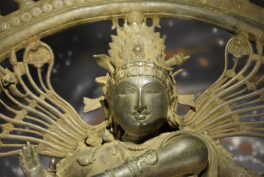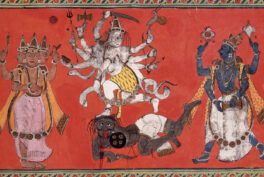Religious Significance
Hanuman is central to Hinduism. He is widely worshipped for his strength and protective qualities. Devotees often pray to him for health and protection from evil. As with most Hindu deities, Hanuman is known by various names. Each carries its own unique significance and symbolism.
The Hanuman Chalisa, a 40-verse hymn composed by Tulsidas, plays a crucial role in daily worship, celebrating his deeds and virtues. Hanuman Jayanti, the festival marking his birth, is observed with various regional traditions. On this occasion, Hanuman’s continuing role as a protector and symbol of unmatched strength in Hindu culture is affirmed.
The Birth of Hanuman
The Puranas, particularly the Hanuman Purana, describe Hanuman’s divine origins. The literature identified Vayu, the wind god, as his father and Anjana, apsara, as his mother. Anjana was marked by a curse that would be lifted by giving birth to a powerful son, a destiny that was fulfilled with Hanuman’s birth.
Hanuman in the Ramayana
In the Ramayana, Hanuman emerges as a heroic figure and a key ally in Lord Rama’s quest to rescue his wife, Sita, from the asura king Ravana. In an iconic episode of the Ramayana, Hanuman is tasked with fetching the life-saving Sanjeevani herb from the Himalayas to heal Rama’s brother, Lakshmana. Unable to identify the specific herb, Hanuman lifts the entire mountain and carries it back. This story demonstrates his immense power and determination, as well as his unwavering loyalty to Lord Rama, and it turns out to be perhaps the most popular one among the artistic depictions of the monkey god.
Hanuman in the Mahabharata
In the Mahabharata, Hanuman appears when the Pandava prince Bhima encounters an elderly monkey blocking his path. Unaware of the monkey’s true identity, Bhima attempts to move him but is humbled by Hanuman’s superior strength.
Hanuman’s Cultural and Artistic Representation
Regional folklore also plays a significant role in shaping Hanuman’s image, with local traditions and storytelling adding unique elements to his portrayal. In North India, Hanuman is often depicted with a prominent, muscular build and a distinctive mace, his weapon of choice. South Indian representations tend to feature more elaborate and colorful attire with intricate details. In Southeast Asia, he is a prominent figure in art and culture, particularly in Indonesian and Thai artworks. He is often depicted in traditional dance dramas and reliefs to reflect the region’s adaptation of Hindu mythology.
Impact on Popular Culture
Hanuman’s influence extends to popular culture. He appears in contemporary Indian comics, graphic novels, and a wide range of Indian television, cinema, and animated series. His appeal stands the test of time. As a symbol of unmatched strength, loyalty, and profound devotion, Hanuman continues to captivate and inspire across various media. He remains admired as a deity in both traditional and modern contexts.













